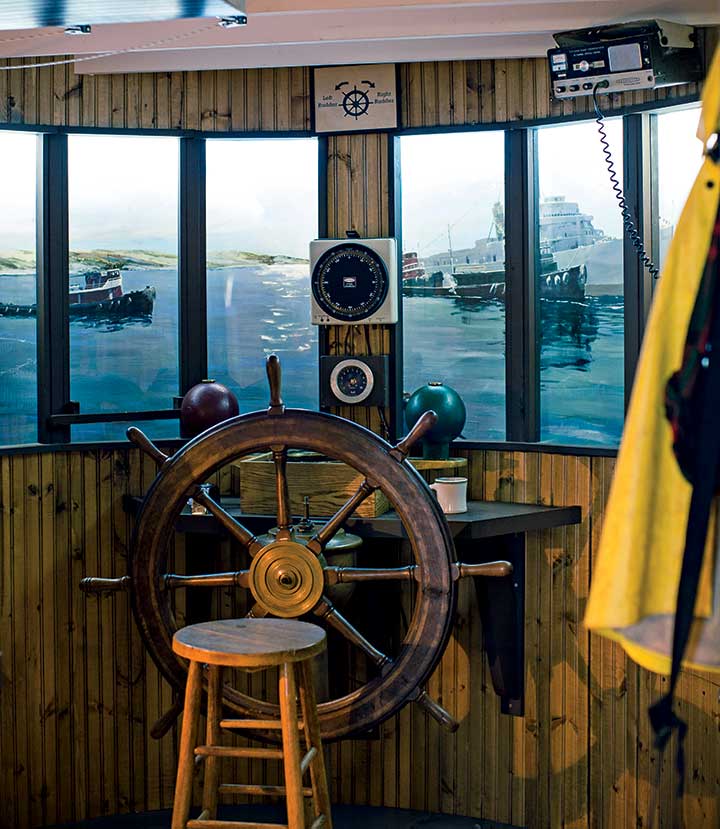As many as 22 shipyards were stacked shoulder to shoulder on the gently sloping eastern bank of Bath, Maine. Visitors of the time could see a whole fleet of wooden vessels in various stages of construction.[slideshow post_id=”554516″]
Like a number of small New England towns, Bath has developed an industry out of being postcard-perfect. Its polished and renovated downtown is anchored by a library at one end and an Irish bar at the other, with all the crafts and antiques you could possibly want to buy in between. It would be easy to mistake Bath for Kennebunk or Rockport if it weren’t for the Aegis cruiser in the river looming over Main Street.
Proudly calling itself “the City of Ships,” Bath continues to be supported by the industry that put it on the map. In its heyday in the 19th century, an army of lumberjacks in the interior of Maine kept the Kennebec River crammed with logs for Bath’s sawmills. As many as 22 shipyards were stacked shoulder to shoulder on the gently sloping eastern bank. Visitors of the time could see a whole fleet of wooden vessels in various stages of construction waiting patiently in their building ways for the crash of a bottle to send them barreling into the river.
At the Maine Maritime Museum, the silhouette of the six-masted schooner Wyoming can still be seen on the shoreline. Towering re-creations of the ship’s bow and stern dominate the grounds, giving visitors a sense of just how far Bath’s craftsmen brought the science of shipbuilding. At 426 feet long, the Wyoming was the largest wooden vessel ever built, and one of Bath’s last, launched in 1909.
Within the museum, curators preserve the stories of the carpenters, blacksmiths, shipwrights, and sailmakers who combined their skills to turn forests into frigates. In their boathouse, the museum keeps their legacy alive through year-round boatbuilding courses for children and adults alike, ensuring that there will always be a few residents of Bath who are comfortable around hand planes and band saws.
The real shipbuilding takes place next door, however, at Bath Iron Works. Owing to extensive contruction at the site scheduled for this summer and fall, the museum’s trolley tours of the facility, offering a glimpse into the noisy and delicate work of piecing together the Navy’s modern warships, have been suspended for this year. The museum is currently developing a new “BIW Insiders” tour, however, featuring current and former Bath workers sharing their stories, with the opportunity to view the shipyard and the Navy’s new high-tech Zumwalt destroyers from the Kennebec River. (Tour details to come at: mainemaritimemuseum.org)
You can hear genuine pride in the voice of one such insider, Roy Ingraham, as he discusses the sensitivity of the sonar dome and the power of the forward Gatling gun, which he boasts can turn incoming missiles “into confetti.” His ties to BIW run deep. For 13 years before his retirement he was a destroyer engineering manager at the yard, helping to launch 10 ships in that time.
He tells us that up until 2001, they still did it the old-fashioned way. When a ship was ready to launch, dignitaries would descend on the shipyard to pontificate on the might of the Navy, the sponsor would break a bottle across the bow, and all 6,000 tons of metal would go screeching down the chute into the water. “Now you go through that whole drill. Same senators, same admirals, same speech,” he says. “The sponsor smashes the bottle of Champagne—and nothing happens!”
Modern warships cost so much money that no one wants them sliding anywhere. Instead they’re rolled out via a trolley to the dry dock at 6 feet per minute and lowered gradually into the river. Ingraham says that there was a time when he never missed a launch; these days, he says, “I just drive by every hour or so and see how far along it is.”
Although some of the romance is gone, at least Bath is still in business. BIW survives one defense appropriations bill to the next. At shift change, workers pass under a sign that states: Through these gates pass the best shipbuilders in the world. They still have reason to believe it.
It’s impossible to know which parts of our maritime culture will survive in the 21st century and which will fade into history. All along the coast, it’s getting harder to earn a living from the sea. The only thing that’s certain is that New Englanders will keep trying. As long as the Atlantic is our neighbor, taunting us with its freedom and beauty, there will be those hardy few willing to devote their lives to its shifting tides and fickle fortunes.
Justin Shatwell
Justin Shatwell is a longtime contributor to Yankee Magazine whose work explores the unique history, culture, and art that sets New England apart from the rest of the world. His article, The Memory Keeper (March/April 2011 issue), was named a finalist for profile of the year by the City and Regional Magazine Association.
More by Justin Shatwell


